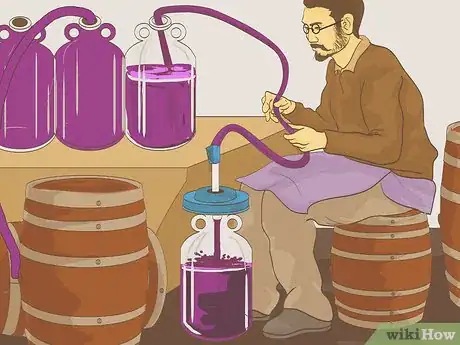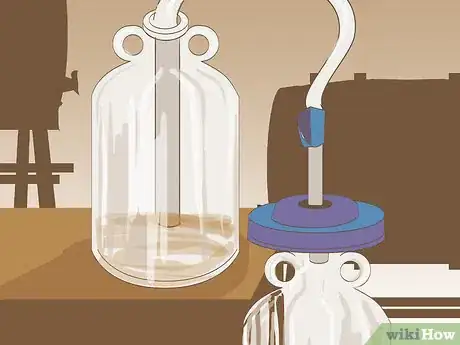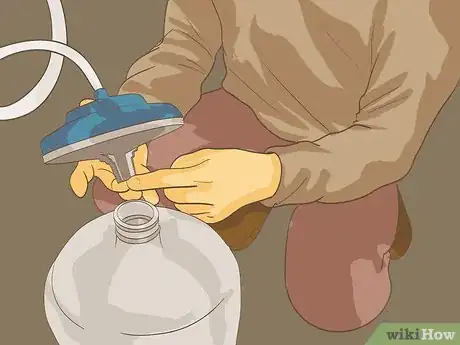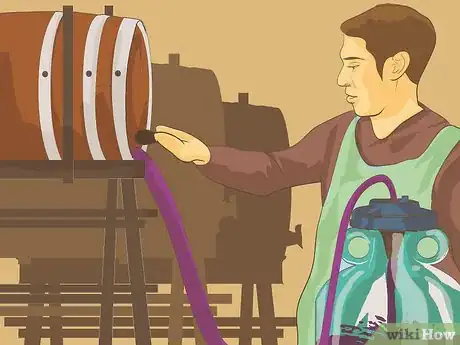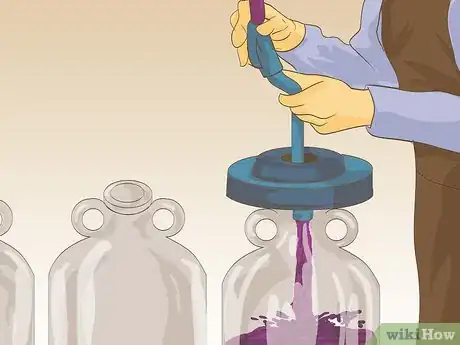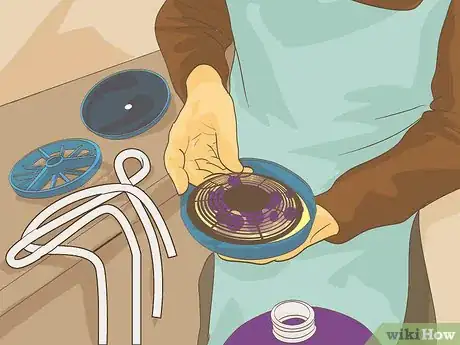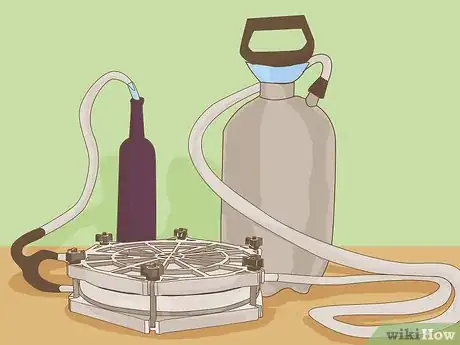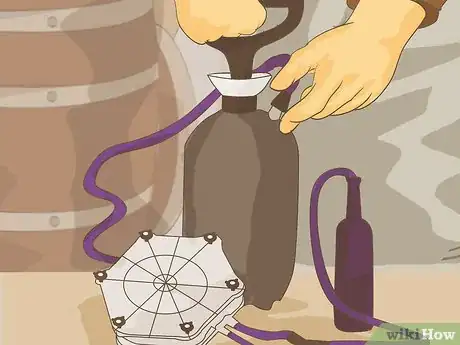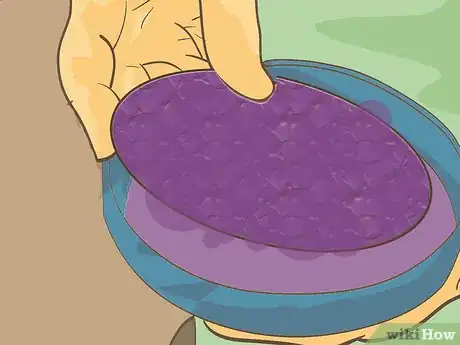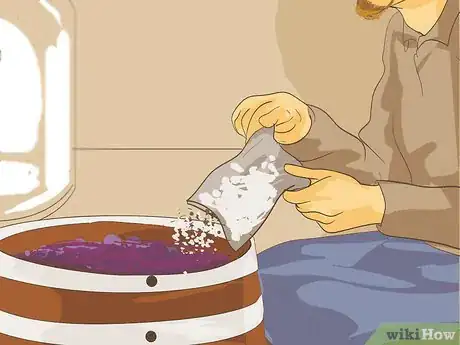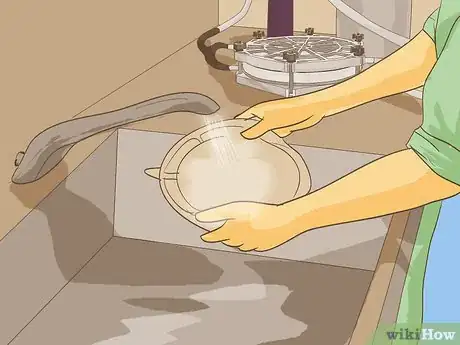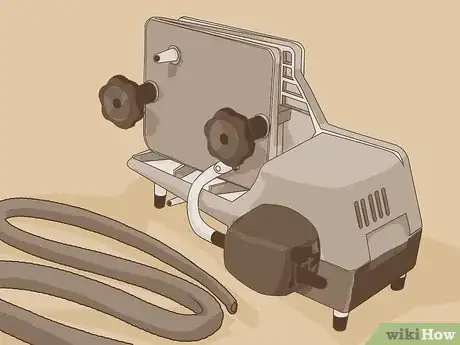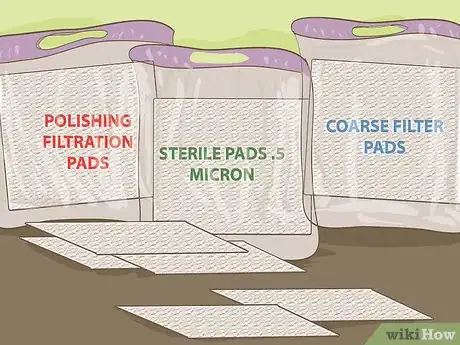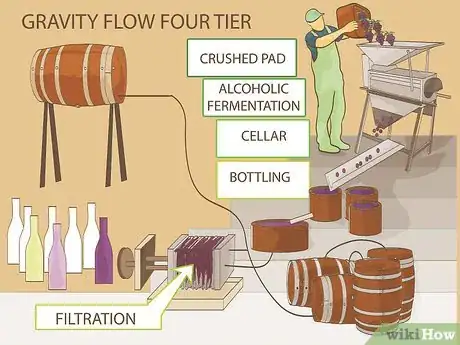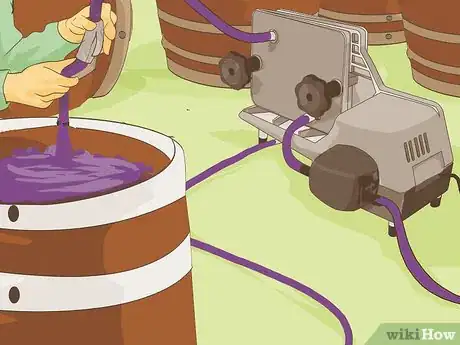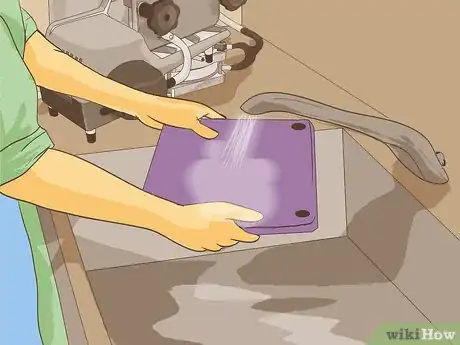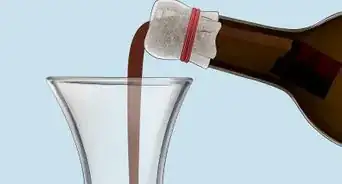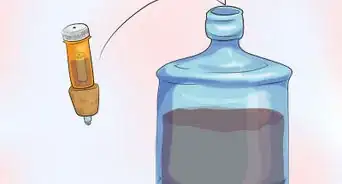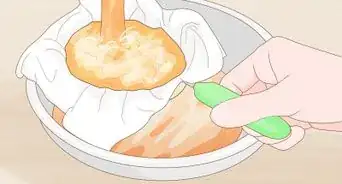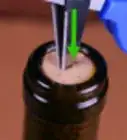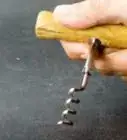This article was co-authored by wikiHow Staff. Our trained team of editors and researchers validate articles for accuracy and comprehensiveness. wikiHow's Content Management Team carefully monitors the work from our editorial staff to ensure that each article is backed by trusted research and meets our high quality standards.
This article has been viewed 67,908 times.
Learn more...
Wines are often filtered at the end of the winemaking process, just before bottling, in order to remove particles and elements like yeast or bacteria. Wine filtration can give wines a clearer and healthier appearance, as well as speed up the aging process. Negatively, it can also remove valuable solids that will help the wine last longer and eventually give it a more nuanced taste. There are three main methods of wine filtration: gravity flow, hand pump, and power pump filtration. [1]
Steps
Using Gravity Flow Filtration
-
1Obtain a gravity flow filter. This method of filtering is the cheapest of all the filtration methods. It works by connecting the filter body, containing a filter pad, with a siphon tube. The siphon tube pushes the wine through the filter.
- This is the cheapest method, but it is also the slowest. The slowness of this process also causes the filter pads to collect yeast and other particles from the wine.
-
2Buy extra filtration pads. The wine is forced through the filter pads. There are three different grades of filter pads.
- Coarse filter pad. This type of pad adds polish to the wine without losing body or color.
- Polish/medium filter pads. This is the type of pad that winemakers most commonly use. It adds polish to wine without removing too much body or color.
- Sterile/fine pads. This type of pad should be used last after the other two pads. The greatest amount of yeast is removed with this pad. It also helps remove the effects of oxidation in your wine.
Advertisement -
3Affix the filter pad to the intake tube. Make sure to affix any other attachments to the intake siphon tube. Position this below the barrel or storage unit.
-
4Attach the outtake tube. Fasten the outtake siphon tube to the release on the barrel or storage unit. Prepare a bottle for the wine to flow into at the other end of the filter pad. Make sure that the system is hooked up properly, and the filtration plates are set up right to prevent leakage.[2]
- Complete any steps in the winemaking process, except cold stabilization, before filtering. Your wine should be in the barrel or storage unit and ready to be bottled prior to beginning gravity flow filtration.
- Sterilize your filtration system before using.
-
5Open the release on the barrel or storage unit. Wine should begin to flow towards the filter pad where it will slow down and trickle through to the bottle.
-
6Replace the bottle with an empty one as it fills. This method is best if you are dealing with one or two gallons of wine at a time. Allow 45 minutes to an hour to filter one gallon of wine.
-
7Observe the buildup of particles on the filter pad. This type of system produces a coarser filtration. For a finer filtration, you will need a mechanical filtration system.
- As wine begins to get stopped up behind the pad, tilt the siphon tube back toward the barrel or storage unit, remove the filter pad, and replace it with a new one.
-
8Clean the filtration system. Use water and sulfite solution. Rinse thoroughly with water.[3]
Filtering with a Hand Pump System
-
1Purchase a hand pump system. This system requires two people to operate. One person is needed to steady and pump, and the other person is needed to switch bottles. It works by pumping the system to push the wine through the tubing to the filtration system.
- This method is faster than using a gravity filtration system.
-
2Buy extra filtration pads. The wine is forced through the filter pads. There are three different grades of filter pads.
- Coarse filter pad. A coarse pad adds polish to the wine without losing body or color.
- Polish/medium filter pads. This is the type of pad used by winemakers. It adds polish to wine without removing too much body or color.
- Sterile/fine pads. Use this pad last. 80% of yeast is removed with this pad. A fine pad also removes the effects of oxidation in your wine.
-
3Connect the outtake tube pump to the barrel or storage. Affix the outtake siphon tube to an empty bottle. Open the release on the barrel or storage unit.
- Make sure to sterilize your equipment before using.
- Have one person operate the pump while another steadies the tube on the bottle, switching out bottles as necessary.
-
4Observe the build-up of particles on the filter pad. As wine begins to get stopped up behind the pad, cease pumping and replace the pad with a new one.
-
5Purchase filtration powder. Apply the process of powder filtration by adding the powder to the wine in small doses. Continue to add powder in small amounts to the wine as you push it through the filtration system.
- Powder filtration works by forming a cake along the filter pad with the filtration powder, allowing the pad to filter out very fine particles.
- Replace your filtration pad constantly. Never reuse pads.
-
6Clean your system. Clean it with water and sulfite solution. Rinse once more with water.[4]
Working with a Powered Pump Filtration System
-
1Buy any type of powered pump filtration system. This is the fastest, most efficient, and most expensive filtration systems. It works by either by creating a vacuum that pulls the wine through the filter, or a powered mechanical pump pushes wine through the filter. This filtration system is best if you want to filter high volumes of wine.
- This type of system produces the finest filtration.
-
2Purchase filtration pads. The wine is forced through the filter pads. The three grades of filter pads are:
- Coarse filter pad. A coarse pad adds polish to the wine without losing body or color.
- Polish/medium filter pads. This is the pad that winemakers most use. A medium pad adds polish to wine without removing too much body or color.
- Sterile/fine pads. This is the last type of pad you should use. The greatest amount of yeast is removed with this pad. It also helps remove the effects of oxidation in your wine.
-
3Assemble your system. Put together your system according to the instructions specific to the brand of filter you purchased. A powered pump system is the easiest type of filtration system to work. Once it’s put together, you just need to plug it in.
-
4Attach the tubes to your system. Attach the intake tube to your barrel or storage unit that is already holding the wine. Attach the outtake tube to the empty storage unit. Next, all that is left to do is turn on your system.
- This type of system can filter one gallon per minute to one gallon per ten minutes, depending on the system.
-
5Clean your system. Wash it with water and sulfite solution. Rinse with water once more after cleaning.[5]
Community Q&A
-
QuestionHow long after filtering wine can I bottle it?
 ayham haj mustafaCommunity AnswerAfter you filter the wine, just leave it lying for 30 minutes and then bottle it.
ayham haj mustafaCommunity AnswerAfter you filter the wine, just leave it lying for 30 minutes and then bottle it.
Warnings
- It is essential that the wine is not exposed to the air as it is filtered, as this will contaminate it. This may be especially difficult during powder filtration, so be sure to purchase a system in which the filtration system and the wine remain in an enclosed area as powder is added.⧼thumbs_response⧽
- Do not filter wine if you plan on aging it for a long time. Filtration is not a substitute for removing sediment upon drinking wine from a bottle. Instead, filtration will rob the wine of those elements that make it improve in quality with time.⧼thumbs_response⧽
Things You'll Need
- Wine in storage (barrel or other storage unit)
- Filtration system
- Extra filter pads
- Empty wine bottles
References
- ↑ http://www.home-winemaking.com/winemaking-3a.html
- ↑ https://winemakermag.com/204-choosing-a-filtering-system-techniques
- ↑ https://winemakermag.com/204-choosing-a-filtering-system-techniques
- ↑ https://winemakermag.com/204-choosing-a-filtering-system-techniques
- ↑ https://winemakermag.com/204-choosing-a-filtering-system-techniques
About This Article
To filter wine, start by getting a gravity flow filter, which is the least expensive method. First, affix a filter pad to the intake tube, which you’ll want to position below the barrel or storage unit. Next, attach the outtake tube to the release on the barrel or storage unit and prepare a bottle for the wine to flow into at the other end of the filter pad. Then, open the release on the barrel or storage unit to allow the wine to flow toward the filter pad and trickle into the bottle. To learn how to filter wine with a hand pump, keep reading!
